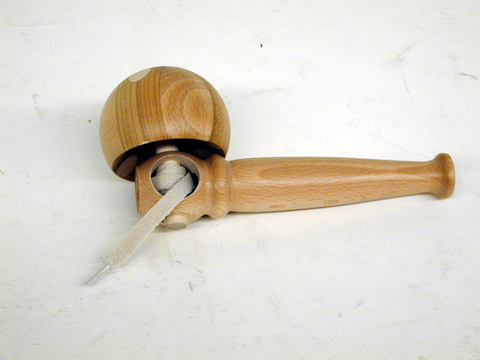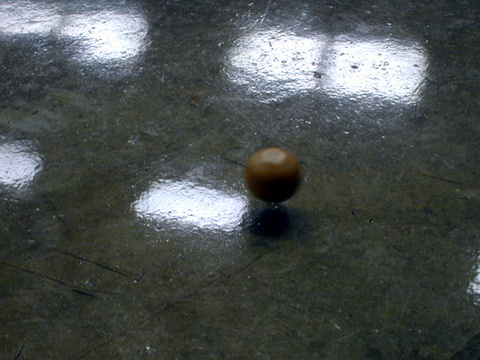Breadcrumb
1Q60.30 - Tippy Top

|

|

|
Code Number: 1Q60.30
Demo Title: Tippy Top
Condition: Fair
Principle: Conservation of Angular, Momentum about Vertical Axis
Area of Study: Mechanics
Equipment:
Tippy - Top.
Procedure:
The Tippy - Top, old fashion top, and the football will all act in the same manner. When spun the frictional torques will cause all of them to rotate about their statically unstable axis.
References:
- Rod Cross, "Why spinning tops and eggs rise", TPT, Vol. 63, #8, Nov. 2025, p. 706.
- Kenneth Brecher and Rod Cross, "Physics of the PhiTOP®", TPT, Vol. 57, #2, Feb. 2019, p. 74.
- Rod Cross, "Spherical Tippe Tops", TPT, Vol. 51, #3, Mar. 2013, p. 144.
- George Barnes, "Tippy Top Thoughts", TPT, Vol. 25, #4, Apr. 1987, p. 200.
- Ralph Baierlein, "Spinning Footballs and Class Rings", TPT, Vol. 24, #6, Sept. 1986, p. 361.
- Brother James Mahoney and Kenneth W. Ford, "Why Does a Finger Ring Flip?", TPT, Vol. 16, #5, May 1978, p. 322.
- D. Rae Carpenter Jr., "L'Eggs Demonstrations", TPT, Vol. 15, #3, Mar. 1977, p. 188.
- George D. Freier, "The Tippy-Top", TPT, Vol. 5, #1, Jan. 1967, p. 36.
- Anastasia Lonshakova, Kyla Adams, David Blair, "Introductory Learning of Quantum Probability and Quantum Spin with Physical Models and Observations", AJP, Vol. 93, #1, Jan. 2025, p. 58.
- Harry Soodak, "A Geometric Theory of Rapidly Spinning Tops, Tippe Tops, and Footballs", AJP, Vol. 70, #8, Aug. 2002, p. 815.
- C. G. Gray, B. G. Nickel, "Constants of Motion for Nonslipping Tippe Tops and Other Tops with Round Pegs", AJP, Vol. 68, #9, Sept. 2000, p. 821.
- Richard J. Cohen, "The Tippe Top Revisited", AJP, Vol. 45, #1, Jan. 1977, p. 12.
- Frank F. Johnson, "The Tippy Top", AJP, Vol. 28, #4, April 1960, p. 406.
- John B. Hart, "Angular Momentum and Tippe Top", AJP, Vol. 27, #3, Mar. 1959, p. 189.
- Ira M. Freeman, "The Tippe Top Again", AJP, Vol. 24, #3, Mar. 1956, p. 178.
- Angelo R. Del Campo, "Tippe Top (Topsy-Turnee Top) Continued", AJP, Vol. 23, #8, Nov. 1955, p. 544.
- C. M. Braams, "The Tippe Top", AJP, Vol. 22, #8, Nov. 1954, p. 568
- William A. Pliskin, "The Tippe Top (Topsy-Turvy Top)", AJP, Vol. 22, #1, Jan. 1954, p. 28.
- D. Van Ostenburg & C. Kikuchi, "Some Analogies of the Tippe Top to Electrons and Nuclei", AJP, Vol. 21, #7, Oct. 1953, p. 574.
- J. A. Jacobs, "Note on the Behavior of a Certain Symmetrical Top", AJP, Vol. 20, #8, Nov. 1952, p. 517.
- Mu-17, Freier and Anderson, A Demonstration Handbook for Physics.
- M-788, "Stability of Spinning Objects", DICK and RAE Physics Demo Notebook.
- Harry F. Meiners, 13-3, Physics Demonstration Experiments, Vol. I, p. 297.
- Jearl Walker, "The Physics of Spinning Tops, Including Some Far-Out Ones", The Amateur Scientist, March, 1981.
- Jearl Walker, "2.73, Tippy Tops", The Flying Circus of Physics with Answers.
- Jearl Walker, "1.106, Tippy Tops", The Flying Circus of Physics Ed. 2, p. 53.
- Christopher P. Jargodzki and Franklin Potter, "225, The Tippe Top", Mad About Physics, p. 89, 226.
- Robert Ehrlich, "12.5 - Tippy Tops and Spinning Electrons", Why Toast Lands Jelly-Side Down, p. 183.